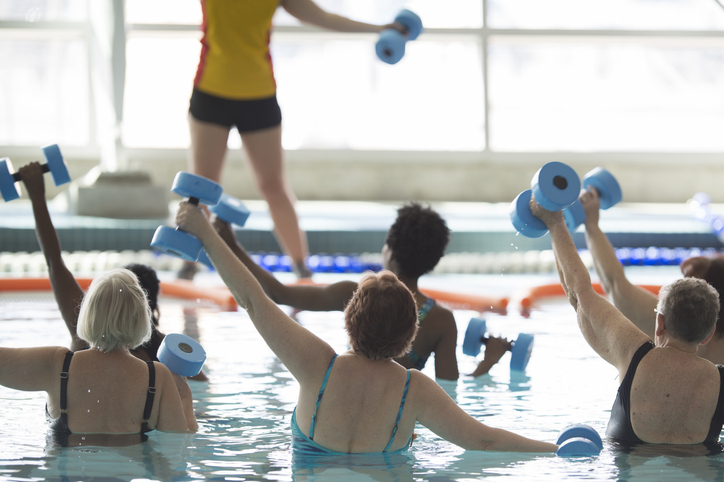Pain
Physical Activity to Prevent or Reduce Neck Pain

Resting the neck used to be the standard treatment for neck pain; however, gently moving the neck is now commonly recommended for neck pain (depending on the specific cause of neck pain). Stretching and moving the neck helps maintain and/or increase mobility and helps relieve muscle tension. Keeping the neck mobile and flexible can help prevent or reduce pain.
It is important to note that caution should be used when stretching or engaging in physical activity as a treatment for neck pain. A health care provider should be consulted for a proper diagnosis and treatment plan before beginning a stretching or exercise regimen. If stretching the neck or engaging in physical activity worsens pain or causes numbness or weakness in the arms or hands, the exercise should be stopped, and a health care provider should be consulted.
Before and after stretching or engaging in physical activity for neck pain, it is helpful to use temperature therapy. Placing a heating pad on the neck prior to stretching warms up muscles and joints, making them more flexible. Applying a cold pack on the neck after exercise can help reduce inflammation in the muscles and joints.
Stretches
The following stretches may help prevent or reduce neck pain:
- Neck rotation
Face forward. Keeping the chin level, slowly and gently turn the head to one side. Hold the position for five seconds. Slowly turn the head back to the forward position. Repeat five times on each side. - Neck tilt
Gently tilt the head down until the chin touches the chest. Hold for five seconds and return to the starting position. Repeat five times. Keep the shoulders straight. - Side-to-side neck tilt
Face forward. Gently tilt the neck so that one ear moves closer to the corresponding shoulder. Hold for five seconds and return the head to its original position. Repeat five times on each side. For a deeper stretch, slightly drop the opposite shoulder while tilting the head. - Neck stretch/chin tuck
Without moving the rest of the body, gently move the chin forward while stretching the throat. Hold for five seconds. Return to the original position. Now, gently retract the chin closer to the neck. Hold for five seconds. Return to the original position. Repeat five times. - Shoulder rolls
Reducing shoulder tension can also help reduce tension in the neck. Sit up straight or stand (without back support if possible). Gently move the shoulder in a circular pattern. Repeat five to ten times. Reverse the motion, and repeat five to 10 more times. - Levator scapula stretch
While standing in a doorway, raise one arm until the elbow is level with the shoulder. Rest the elbow against the side of the doorframe. Turn the head 45 degrees and gently tilt the chin down and toward the collarbone opposite the raised arm. Hold for 30 seconds; repeat on the other side. - Wall angel
Stand with the back flat against a wall. Create a “T” shape with the arms,then bend the elbows 90 degrees. Slowly move the arms up and down (similar to making a “snow angel”). Make sure to keep the arms flat against the wall. Repeat three sets of 10 reps. - Corner stretch
Stand in the corner of a room or in a doorway. Place the forearms on each wall (or on each side of the doorframe) with the elbows slightly below shoulder level. Gently lean forward until a comfortable stretch is felt in the chest. Hold for 30 to 60 seconds. Repeat three to five times. - Resistance
Resistance stretches can help strengthen the neck muscles. Face straight forward. Place one palm on the side of the head, just above the ear. Gently press the head into the palm. Hold for 30 seconds. Repeat on the other side.
Physical activity
The following activities may help prevent or reduce certain types of neck pain:
- Aerobic activity
Aerobic exercise involves using large muscle groups in a rhythmic, continuous manner to increase heart rate and promote blood circulation. Engaging in aerobic exercise increases blood flow to the muscles and soft tissues, which helps relieve tension and promotes flexibility. Low-impact aerobic exercise is gentler on the body, as it puts less pressure on the joints. Examples of low-impact aerobic exercise include walking and cycling.
To reap the maximum benefits of aerobic exercise, it should be practiced from three to five times a week for 20 to 30 minutes. Of course, as with any exercise program, starting slowly and gradually increasing to the desired duration and intensity is recommended. - Yoga
Practicing yoga relaxes the muscles, relieves tension, and improves range of motion. Maintaining flexibility in the neck can help prevent or reduce neck pain. Certain yoga poses, such as warrior II pose, can help strengthen the chest and shoulder muscles to better support the neck.


















